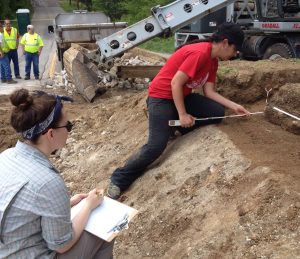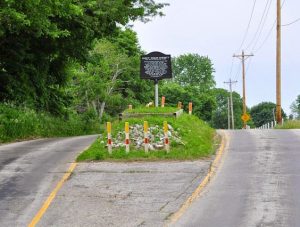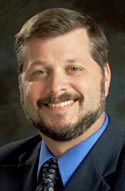Archaeology team studying fabled gravesite
 UIndy grad students Rose Perash (left) and Fatma Zalzala begin work at the so-called “grave in the middle of the road,” located between Franklin and Edinburgh.
UIndy grad students Rose Perash (left) and Fatma Zalzala begin work at the so-called “grave in the middle of the road,” located between Franklin and Edinburgh.
Peculiar 19th century burial rests in center of Johnson County road

NEWS COVERAGE:
Indianapolis Star (with photo gallery)
WXIN-Fox59
WTHR-TV 13
WISH-TV 8
WRTV-6
Daily Journal
Inside Indiana Business
A student and faculty archaeology team from UIndy is digging into the mystery of a famous Johnson County grave and the lives of central Indiana’s earliest white settlers.
The remains of Nancy Kerlin Barnett, who lived from 1793 to 1831, rest in an island of grass and rock that sits smack in the middle of County Road 400S near Interstate 65 south of Franklin. The site is often referred to simply as “the grave in the middle of the road,” or less accurately, “the Indian grave.”
According to local lore, Barnett’s grandson guarded the grave with a shotgun when other surrounding graves were moved in the 1900s for construction of the road.
The site is a nationally known curiosity for travelers and for thrill-seekers who claim the area is haunted. It’s also a traffic hazard that is regularly struck by passing vehicles, which is why the Johnson County Highway Department intends to lower the elevation of the grave mound and reconfigure the roadway for the protection of motorists and the grave itself.

The UIndy team, six graduate students led by Professor Christopher Schmidt of the Department of Anthropology, will temporarily remove and study Barnett’s remains at the university, returning them to the site when the roadwork is completed. The Johnson County Museum of History is a partner in the project and invited the researchers to handle the exhumation.
Barnett’s remains are of scientific and historical interest because she represents the first white settlers to live in the area, says Schmidt, director of UIndy’s Indiana Prehistory Laboratory.
“She’s older than the state of Indiana,” he says. “She will tell us what life was like for people living in that time.”

Once the skeletal remains are removed and taken to UIndy, the researchers will study them for clues to Barnett’s ancestry, diet, work habits and perhaps the circumstances of her death.
Before the dig begins, the team will plot a grid over the site and use ground-penetrating radar to more closely pinpoint the location and depth of the burial. Collaborating on the project are Associate Professor Christopher Moore and Assistant Professor Leah Courtland of UIndy’s Department of Physics & Earth-Space Science.

“The radar hopefully will point to where the grave shaft is,” Schmidt says.
After the project is complete, the UIndy professors hope to present a public archaeology event to share the process and the findings with interested residents.
